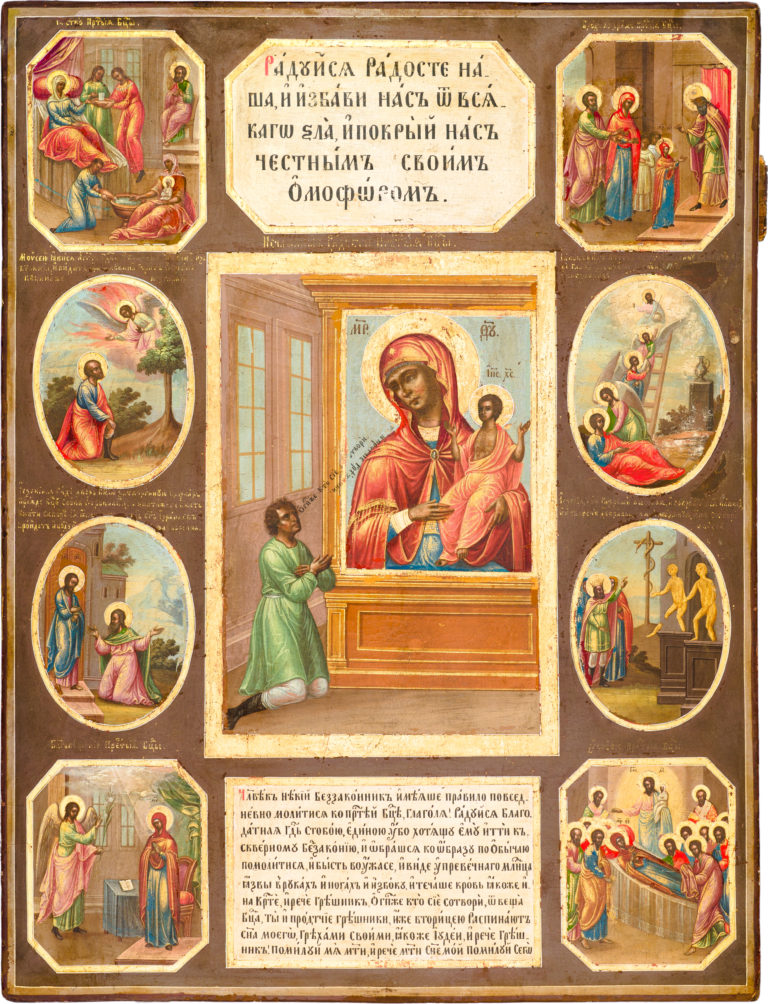The Unexpected Joy Icon of the Mother of God, with Marian Feasts and Old Testament prophecies
Antique Russian icon. Third quarter of the 19th century. Moscow (?).
Size: 58 х 44 х 3 cm
Wood (two panels), two incut profiled support boards, absence of the incut centerpiece, underlying layer of canvas is not visible, gesso, tempera.
The author’s paintwork is well preserved; slight chafing.
Contact us

The Unexpected Joy Icon of the Mother of God, with Marian Feasts and Old Testament prophecies
Diagram of the border scenes:
- The Nativity of the Mother of God;
- The Entrance of the Mother of God into the Temple;
- The Annunciation;
- The Dormition of the Mother of God;
- Moses before the Unburnt Bush;
- Jacob’s vision of the Latter;
- Ezekiel’s vision of the Closed Gates;
- King Hezekiah destroys the Bronze Serpent.
The iconographic scheme of the given antique Russian icon contains the central venerated image of the Mother of God – “The Unexpected Joy.” It is surrounded by the main Marian Feasts (the Nativity of the Mother of God, the Entrance of the Mother of God into the Temple, the Annunciation, the Dormition of the Mother of God) in diagonally-angled shields and the Old Testament prophecies enclosed in ovals and placed at the sides of the religious icon centerpiece. The upper and lower fields contain texts of the Akathistos to the Pokrov of the Mother of God (“Rejoice, our Joy, and deliver us from all evil, and cover us with your omophorion”) and the fragment of the Legend of the Unexpected Joy Icon as told by St. Demetrius of Rostov in his treatise “The Watered Fleece.” Thus, the Wonder-working religious icon and scenes of Marian veneration are placed along a single axis, which gives the image an intense devotional character.
Marian Orthodox Christian icons supplemented by additional devotional scenes became popular in the 19th century, reflecting the believers’ need for divine intervention and aid. The narrative source for the “Unexpected Joy” iconography was St. Demetrius of Rostov’s treatise “The Watered Fleece” (1680). The treatise contains the description of miracles from the Marian icon of St. Elias monastery in Chernigov, supplemented by various other texts. One of such narratives contains the story of a lawless man who always prayed before the saint icon of the Mother of God before going out on another evil deed. One day, he saw blood issuing from the hands and feet of the Baby Jesus. Struck by what he saw, the man asked the Mother of God, why Christ’s wounds were opened. In response, he heard that it was because sinners crucify Jesus again and again. Repenting, the man began praying to the Mother of God asking for Her intercession on his behalf. Christ denied Her three times; and only when the Mother of God fell on Her knees before Her Son, the Savior forgave the sinner. That is why that saint icon was called the “Unexpected Joy” – as a symbol of the Unexpected Joy of Salvation and Forgiveness and the sign of the endless Mercy of the Mother of God.
It is unknown which religious icon was associated with the miracle, but it was not the main venerated Orthodox icon of St. Elias Monastery. Moreover, St. Demetrius’s text does not call that saint icon “The Unexpected Joy;” this title was given to it in a later period. Most likely, the narrative and the iconography were taken from the Western Christian religious icon art tradition. The veneration of this particular Orthodox icon became widespread only in the middle-second half of the 19th century and was closely tied with the miraculous healings that took place in 1837 and came from the oldest known “Unexpected Joy” icon kept in the Mother of God the Unburnt Bush Church in Moscow’s Khamovniki district. The origins of the holy icon’s veneration closely tie together the two Marian images – The Unburnt Bush and the Unexpected Joy. That is why the given antique Russian icon includes Old Testament prophecies associated with the Mother of God: “Moses before the Unburnt Bush” (Exodus 3: 1-8), “Jacob’s Latter” (Genesis 28: 12-22), “Ezekiel’s vision of the Closed Gates” (Ezekiel 44:1-3), which traditionally accompany the Unburnt Bush iconography.
Stylistic traits of this hand-painted icon, the artist’s manner of depicting faces, the peculiar, highly aesthetic color juxtaposition (the dark-brown background, on which we see border scenes with their powerful greens, blues, crimson reds, and soft lilacs depicted in likeness of enamel medallions), the high-class artistry, and the unique iconographic concept – all attest to the fact that the given antique Russian icon was painted in Moscow in the third quarter of the 19th century (most likely in the 1860s-1870s).